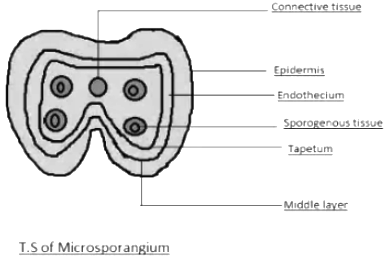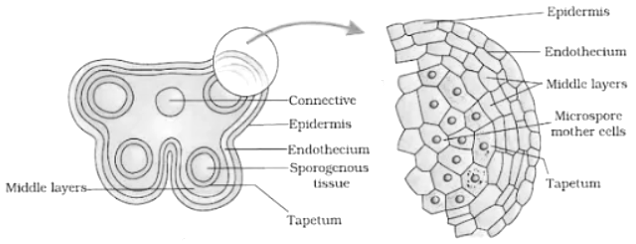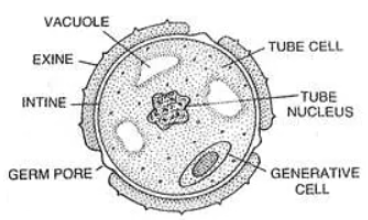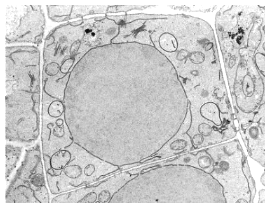Microsporangia are sporangia that produce microspores, which germinate and produce male gametophytes. All vascular plants with heterosporic life cycles, such as seed plants, spike mosses, and the water fern genus Azolla, have microsporangia. Microsporangia create microsporocytes, the microspore mother cells, in gymnosperm and angiosperm anthers, which subsequently produce four microspores through the meiosis process. The microsporangia of gymnosperm cones and the anthers of angiosperms both yield microsporocytes. They’re diploid microspore mother-cells that go through meiosis to make four haploid microspores. These become pollen grains, which contain microspores that split twice during mitosis to generate a very basic gametophyte.
Microsporangia
Microsporangia are sporangia that produce male gametes and microspores. All plants with heterosporic life cycles, including spike mosses, have microsporangia. In gymnosperm and angiosperm anthers, microsporangia produce microsporocytes, the microspore mother cells, which then produce four microspores by meiosis.

Male plant gametophytes frequently develop and mature in the anther of the plant. The portions of the anther that produce pollen or microspores are known as microsporangia. To understand what a microspore is, we must first define it.
Microspores are plant spores that produce male gametophytes, which develop into sperm cells, which then fuse with egg cells to form a zygote.
Structure of Microsporangia
Microsporangia are bi-lobed structures found at the end of the long filament-like stamen that function as pollen sacs in a plant’s anther. Microsporangium has a circular form with four layers encircling it. The following are the details:
- When the epidermis matures, it stretches and then falls off in a specific pattern.
- A fibrous endothecium is a type of cell with fibrous ends.
- The layers in the middle are the most important. The cells in the intermediary layers of a fully developed anther normally break down.
- A tapetum layer with dense cytoplasm and uninucleate, binucleate, or multinucleate layers.

The outermost coast of the microsporangium protects the microspores and aids in the ejection of pollen grains from the anther. The tapetum not only feeds the pollen, but it also provides some crucial components to the pollen wall.
Pollen grains that have developed contain two types of cells. They are pollen tube cells and generative cells. A pollen tube is generated from the tube cells during germination. The cell migrates into the ovary via the pollen tube. Inside the pollen tubes, the generative cells divide into two gametes or sperm.
Formation of Microsporangia
Microsporangium production is a complex biological process that begins in a plant’s early anther with actively growing meristematic cells. The pollen grains are found in the anther, which is a stamen component. These meristematic cells are surrounded by a thin layer of epidermis, which quickly expand into a bi-lobed structure. Each lobe then generates a pair of pollen sacs, for a total of four pollen sacs on a two-lobed anther. These sacs are made up of cells that divide to form the primary sporogenous layer and are found in the four corners of the anthers.

There’s a small difference between microsporangia and microsporangium as well. A sporogenous tissue container is a collection of microsporangium, whereas a microsporangium is a single container.
Pollen Grains
Pollen tube cells and generative cells make up the two types of cells that make up a mature pollen grain. The tube cells expand into the pollen tube after successful germination, while the generative cell enters the ovary through the pollen tube. Within a large pollen tube cell, productive cells divide to form a pair of gametes or sperm cells. When the anther develops, all of the pollen grains are released for fertilisation.

Sporogenous Tissue
They are present in the centre of each microsporangium as juvenile anther. As the anther grows, the sporogenous cells split meiotically to form microspore tetrads. A pollen mother cell or a microspore mother cell is the name given to each sporogenic cell. Microsporogenesis is the process by which a pollen mother cell transforms into a microspore. In a tetrad pattern, the microspores are arranged. As the anther matures, the microspores separate from one another, forming a pollen grain.

The Functional game
Microsporangia (male) produce microspore-capitulating gametes (called microsporocytes). Mega sporangia female component, on the other hand, produces gametes (megasporocytes) that aid in the production of megaspores. Microsporangium and pollen grain play an important part in reproduction because the latter is the successor of the former, and pollen sacs are always borne on Microsporangium’s lower sections. The stamen is made up of spore capsules that grow into microspores, or prospective pollen grains. Each ovule in the pistil contains an egg, and a pollen grain is formed when a microspore germinates in the pistil along with the egg.
Conclusion
Microsporangium are minute structures in plants that germinate and produce gametes. They are found in Tracheophytes, which have two sizes or sexes. Spermatophytes, which are plants that generate seeds and are hence known as seed plants, are one example of Microsporangium, as are aquatic fern plants. They are bi-lobed and have structures with two lobes. The Microsporangium has a single epidermis, Endothecium, Middle Layers, and Outermost Layer structure. The microspores are protected by the outermost layer. Microsporangia is the male component, and megasporangia is the female part. Pollen grains include microspores, which divide twice during mitosis to produce a very primitive gametophyte.
 Profile
Profile Settings
Settings Refer your friends
Refer your friends Sign out
Sign out






